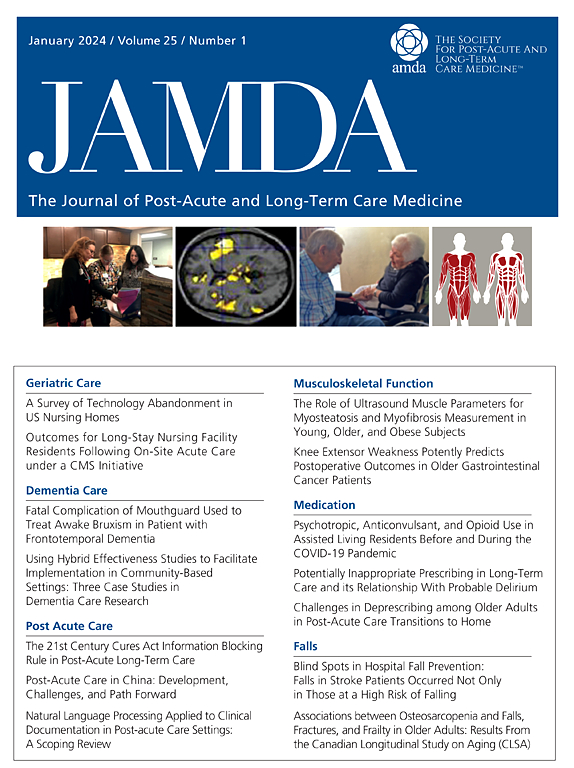Use of Point-of-Care Ultrasound in Home vs Non-home Medical Care Physicians in Japan
IF 4.2
2区 医学
Q2 GERIATRICS & GERONTOLOGY
Journal of the American Medical Directors Association
Pub Date : 2025-03-14
DOI:10.1016/j.jamda.2025.105536
引用次数: 0
Abstract
Objectives
To compare the use of point-of-care ultrasound between physicians providing home medical care and other physicians in Japan.
Design
A cross-sectional comparative study.
Setting and Participants
The participants were members of 3 societies related to home medical care in Japan.
Method
A web-based survey was conducted between April and June 2024 to assess use of point-of-care ultrasound, physicians’ training history and needs in this technique, ultrasound machine availability and types, and barriers and facilitators for wider adoption.
Results
Overall, 692 physicians (461 providing home medical care) participated. There were more point-of-care ultrasound users among those providing home medical care (75.9% vs 67.1%; P = .014). There was no significant difference in training history (34.3% vs 36.4%; P = .587), but training needs were significantly greater among home medical care providers (80.9% vs 66.7%; P < .001). This group also had better access to ultrasound machines (53.6% vs 35.5%; P < .001), with higher personal ownership rates and handheld device usage (29.1% vs 4.8%, P < .001; 59.7% vs 13.2%, P < .001). The main barrier was insufficient training opportunities, especially for home care providers (61.6% vs 51.5%; P = .011), followed by inadequate training environments (46.4% vs 32.9%; P = .001), challenges in image acquisition (59.0% vs 37.2%; P < .001), and interpretation skills (51.4% vs 32.9%; P < .001). Facilitators included improved access to ultrasound machines and increased training opportunities and available mentors, with home care providers significantly emphasizing training opportunities (71.2% vs 62.3%; P = .019).
Conclusions and Implications
Home medical care providers were more likely to use point-of-care ultrasound and have better access to machines; however, they faced barriers related to skills and training opportunities. As handheld devices become prevalent, systematic training in this technique is becoming essential.
日本家庭与非家庭医疗护理医师使用即时超声的情况。
目的:比较日本提供家庭医疗护理的医生和其他医生在护理点超声的使用情况。设计:横断面比较研究。背景和参与者:参与者是日本家庭医疗相关的3个协会的成员。方法:在2024年4月至6月期间进行了一项基于网络的调查,以评估现场超声的使用情况、医生对该技术的培训历史和需求、超声机的可用性和类型以及广泛采用的障碍和促进因素。结果:总共有692名医生(461名提供家庭医疗服务)参与。在提供家庭医疗护理的人群中,有更多的即时超声使用者(75.9% vs 67.1%;P = .014)。两组在训练史上无显著差异(34.3% vs 36.4%;P = .587),但家庭医疗服务提供者的培训需求显著更高(80.9%比66.7%;P < 0.001)。这一组也更容易获得超声仪(53.6% vs 35.5%;P < 0.001),个人拥有率和手持设备使用率更高(29.1% vs 4.8%, P < 0.001;59.7% vs 13.2%, P < 0.001)。主要障碍是培训机会不足,特别是对家庭护理人员(61.6% vs 51.5%;P = 0.011),其次是培训环境不足(46.4% vs 32.9%;P = .001),图像采集方面的挑战(59.0% vs 37.2%;P < 0.001),口译能力(51.4% vs 32.9%;P < 0.001)。促进因素包括改善超声波机的使用,增加培训机会和可获得的导师,家庭护理提供者显著强调培训机会(71.2%对62.3%;P = .019)。结论和意义:家庭医疗服务提供者更有可能使用即时超声,并且更容易获得机器;然而,他们面临着与技能和培训机会有关的障碍。随着手持设备的普及,这项技术的系统培训变得至关重要。
本文章由计算机程序翻译,如有差异,请以英文原文为准。
求助全文
约1分钟内获得全文
求助全文
来源期刊
CiteScore
11.10
自引率
6.60%
发文量
472
审稿时长
44 days
期刊介绍:
JAMDA, the official journal of AMDA - The Society for Post-Acute and Long-Term Care Medicine, is a leading peer-reviewed publication that offers practical information and research geared towards healthcare professionals in the post-acute and long-term care fields. It is also a valuable resource for policy-makers, organizational leaders, educators, and advocates.
The journal provides essential information for various healthcare professionals such as medical directors, attending physicians, nurses, consultant pharmacists, geriatric psychiatrists, nurse practitioners, physician assistants, physical and occupational therapists, social workers, and others involved in providing, overseeing, and promoting quality

 求助内容:
求助内容: 应助结果提醒方式:
应助结果提醒方式:


